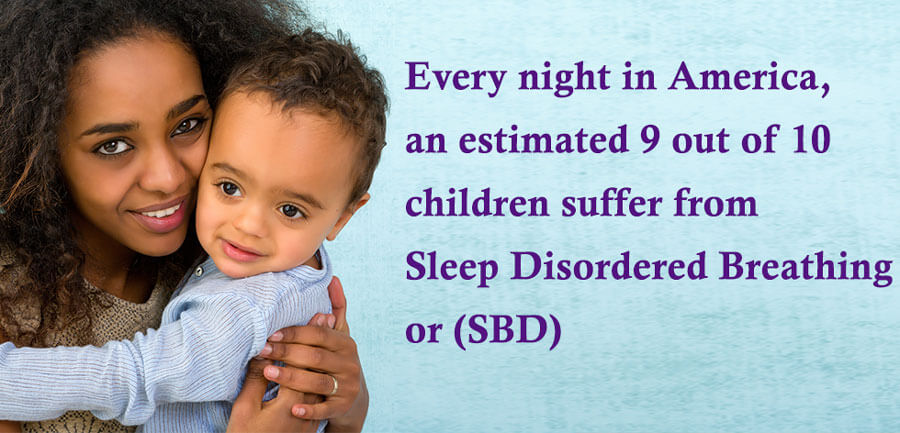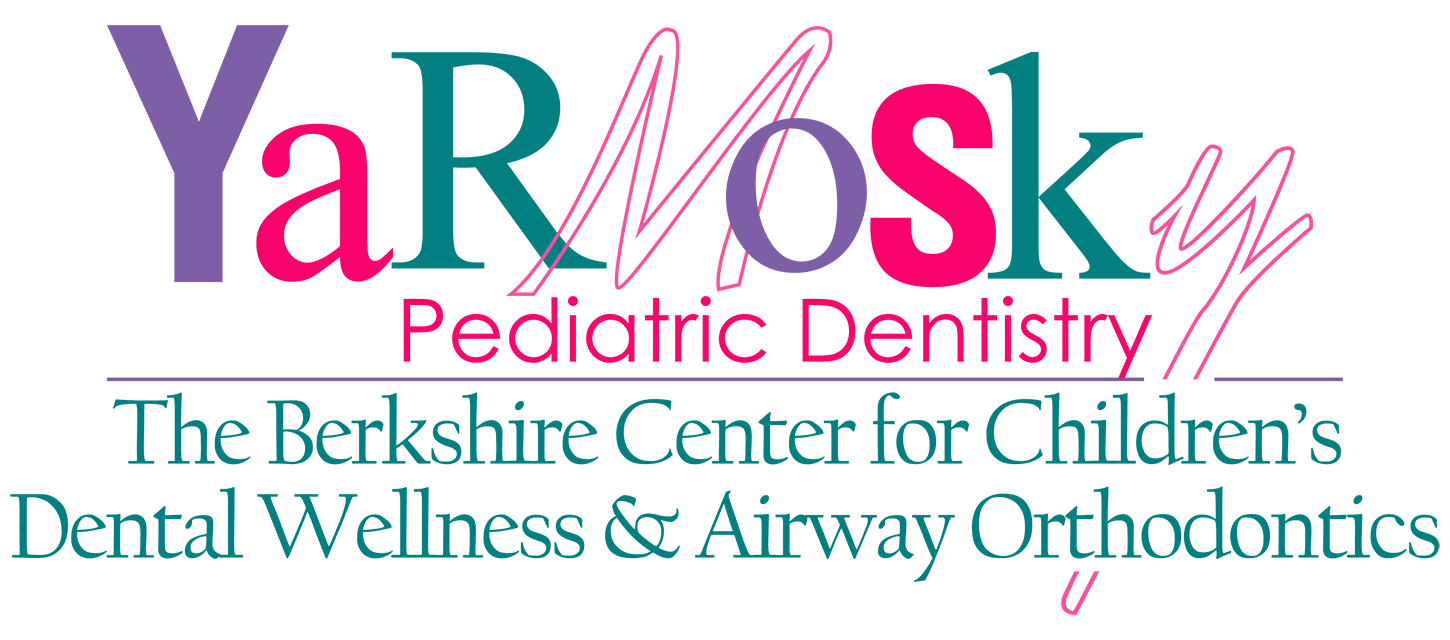Airway Health & Sleep Disordered Breathing
Breathe Well, Sleep Well and Smile Brochure
Airway Health and Sleep Disordered Breathing (SDB) in children is a much more critical and common problem than what has previously been thought. SDB can manifest itself in a variety of symptoms that can be easily overlooked, misdiagnosed, and most unfortunately often left untreated. The symptoms associated with SDB can include mouth breathing, loud snoring and fatigue can point to serious underlying health issues and the need for treatment. 20 years of research has identified an association between Sleep Disordered Breathing and crowded or crooked teeth or other dental concerns. SDB can have a lasting impact on your child’s growth and development and even create behavior challenges similar to ADD/ADHD or bedwetting.
Sleep Disordered Breathing
Sleep Disordered Breathing in children is a much more critical and common problem than what has previously been thought. SDB can manifest itself in a variety of symptoms that can be easily overlooked, misdiagnosed, and most unfortunately often left untreated. The symptoms associated with SDB can include mouth breathing, loud snoring and fatigue can point to serious underlying health issues and the need for treatment. 20 years of research has identified an association between Sleep Disordered Breathing and crowded or crooked teeth or other dental concerns. SDB can have a lasting impact on your child’s growth and development and even create behavior challenges similar to ADD/ADHD or bedwetting.
The central issue for many children suffering from the effects of Sleep Disordered Breathing (SDB) or Obstructive Sleep Apnea (OSA) is a compromised airway. When a child’s airway is narrow, underdeveloped or obstructed in any way, the child will struggle to receive enough oxygen during the night, wake-up or change position to breathe, causing fragmented and interrupted sleep. This cycle leads to mouth breathing and an open mouth posture during the day, compounding the issue and makes things worse.
Daytime issues like an open mouth posture and mouth breathing and structures like narrow palates and retrognathic jaw position cause further issues at night while sleeping. Snoring and apnea decrease oxygen supply to the body and brain, interrupt sleep and prevent the child from obtaining the vitally important stages of deep and REM sleep. Sleep Disordered Breathing, that can range from Snoring to Obstructive Sleep Apnea, is a vicious cycle and leads to symptoms such as:
- Swollen tonsils and adenoids
- Frequent ear and upper respiratory infections
- Bed wetting
- More severe allergies, asthma
- Digestive issues
- Disrupted sleep patterns
- Delayed growth
- Depression
- Headaches
- ADD/ADHD like behavior
- Cognitive and learning issues
- Poor memory and ability to focus
- Aggression and socialization issues

Airway focused orthodontic treatment not only results in beautiful smiles, but offers a CURE for children suffering from SDB or OSA or PREVENTS it in children who might be at risk. Proper orthodontic treatment can open up and develop the airway of a growing child by expanding the upper palate, bringing the upper and lower jaws forward and allowing the airway to widen.
It is vital to not only address the underlying causes of both SDB and dental malocclusion but to also ensure that the causative issues do not reoccur. By incorporating the MYOBRACE SYSTEM and the MYOFUNCTIONAL TRAINING ACTIVITIES into our orthodontic care, we can help your child eliminate damaging habits like mouth breathing, improper swallowing and tongue thrusting and offer a true CURE.
By evaluating and screening your child for LIP-TIES OR TONGUE-TIES (tight maxillary and lingual frenum attachments) and offering procedures when appropriate, we can treat the anatomical barriers to good airway growth and health
Proper oxygenation through correct breathing, a healthy airway and a full night’s sleep in turn lead to an improved immune and hormonal system, better school and sports performance and an overall healthier and happier child. BEAUTIFUL STRAIGHT TEETH ARE THE ICING ON THE CAKE.
Teeth & Airway Health
The position of the teeth, even as early as 2 years old, can indicate insufficient jaw size, poor airway development and be a symptom of poor myofunctional habits that can lead to Sleep Disordered Breathingand Obstructive Sleep Apnea. The earlier the signs are recognized and treated, the healthier your child will be.
No Spacing or Crowding Between Baby Teeth
A normal and healthy bite with all the primary teeth present will appear to have SPACES between all the baby teeth. This is a good indication that the tongue is correctly placed on the roof of the mouth and is acting like a “scaffold” for proper tooth position and palate size development. Permanent teeth that come in after the baby teeth fall out are much bigger and wider than the baby teeth they replace and need the extra room spacing provides. No spaces between your child’s baby teeth usually indicate not only that the adult teeth are going to be crowed or even “crowed out completely”, but also indicate that the dental arches are too narrow and can lead to poor facial growth and unhealthy airway development. Early intervention and treatment can not only prevent the need for braces which will likely be inevitable, but can also prevent poor airway development that can lead to poor heath and sleep.
Tooth Wear and Chipping
When the teeth look “flattened, ” worn-down, short or chipped, it can indicate tooth grinding or bruxism and point to a potential airway problem. If a child is having a hard time getting enough oxygen while sleeping, the body will unconsciously respond to try and make breathing easier. One way the body accomplishes this is by moving the lower jaw forward (like the “jaw thrust” in CPR) to automatically open the airway. With repeated movement of the lower jaw coming forward, not only will you hear “tooth grinding” sounds, you will see damage to the teeth. Hearing or seeing evidence of tooth grinding means that your child is likely struggling to get enough oxygen while sleeping and treatment should begin as early as possible to cure this serious problem.
Over-Closed or “Deep” Bite
When a child bites down and the lower incisors are hardly visible, this means there is an over closed or “deep bite” bite and a vertical discrepancy, which has serious future consequences for airway size and growth and development if not treated early.
An “Open” Bite
Front top and bottom teeth that do not overlap at all when the back teeth are touching and have a large gap or space between them (for example you could stick the tongue “through” the gap) are usually the result of a habit such pacifier or thumb sucking. Often it appears that the canine teeth are “longer”, when in fact the upper front 4 teeth are actually pushed “up” higher than the rest of the teeth. Unfortunately, this “open bite” leads to poor myofunctional issues like an open mouth posture and low tongue position, a tongue thrust, mouth breathing and further constriction of the palate leading to poor jaw growth and airway development compromise. Even though sucking and soothing habits are “normal” for babies and infants, the sooner they are addressed and stopped, the better. Early corrective and conservative treatment should be the goal in order to put the growth pattern of the face, jaws and teeth back on track and the correct any poor myofunctional habits that often coexist.
Front Crossbite
A cross-bite involving the front teeth: if the lower teeth are biting in front of the upper teeth, it is a situation that demands immediate intervention. The condition will prevent the upper jaw from growing forward and as the teeth grow longer with time, it will be harder to reverse the cross-bite.
Side Crossbite
A cross-bite involving the side primary molars means that the top jaw is smaller than it should be and is an indication of a constricted palate which is a risk factor for poor airway development and should receive immediate intervention.
Around age 8, as the baby upper lateral incisors are shed, if the palate is constricted, there will be very little space or no for the permanent laterals to erupt. These teeth need at least 7 mm of room to come into the mouth properly. Unless the palate is expanded and room is made, the loss of space will not be regained. In addition to severe tooth crowding, a constricted palate is a sign of unhealthy air way development and improper jaw growth. Early treatment around age 7 or 8 is vital.
Extreme “Overjet” and “Overbite”
Although the top teeth may look like they are way too forward and should be “pulled back”, its actually the opposite. The top teeth may look “buck”, but they are actually positioned in the maxillary arch correctly and the trouble lays with the underdevelopment of the lower jaw. This lower jaw “protrusion” is also known as a “retrognathic mandible.”
This type of “bite” and jaw position puts a child at extremely high risk for developing a constricted airway and Obstructive Sleep Apnea. Treatment to help guide the lower jaw forward should begin as young as possible knowing that the jaw basically stops growing around the time all the permanent teeth come in, usually around age 12. The earlier treatment for this condition begins, the more conservative and effective it can be. Waiting too long can result in unfavorable treatment options, including jaw surgery and if not addressed at all, will likely lead to OSA and poor health.
Flared Lateral Incisors
If lateral incisors are fully erupted around age 9, and they look like they are flared sideways, this is a warning that there is impending crowding. Due to a lack of space, the underlying canines are pushing against the roots of these laterals and shifting their position. This can be detected with early screening and good imaging, preventing potential damage to the permanent lateral tooth roots as well as creating room for the permanent canines to erupt in a more normal path.
Displaced Canines
Around age 11, the upper canines will appear. Among all the permanent teeth, these travel the longest path before they emerge. They start their journey from the space right next to the nose, almost under the eye, and travel down over many years. If there is insufficient space due to a constricted palate, they will emerge “ectopically,” or sideways, or they will be impacted within the palate. Complications and lengthy treatment time can be avoided with early treatment.
Frenums – “Tongue and Lip Ties”
If the tongue is RESTRICTED and UNABLE to touch and rest on the upper palate, a simple Frenectomy procedure may be necessary to improve your child’s health and dental issues. We are proud to be members of the Academy of Laser Dentistry and to use the State-of-the-art Lightscalpel© CO2 laser.
The Nose is for Breathing, the Mouth is for Eating
Aides for Better Breathing
Content coming soon.
